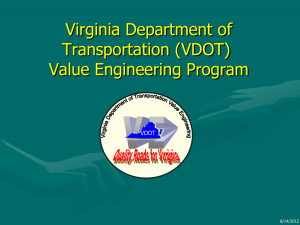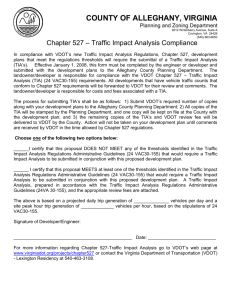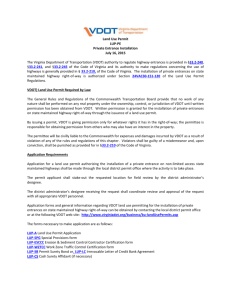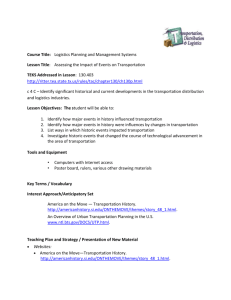04/08/2014 Private Utility Service
advertisement
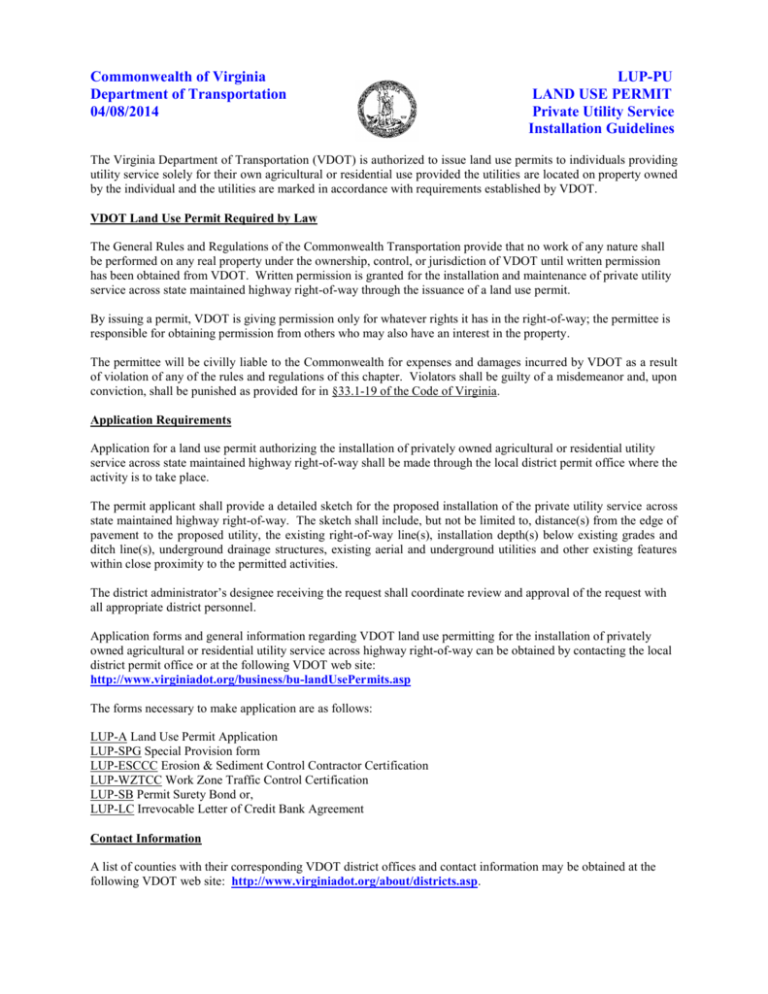
Commonwealth of Virginia Department of Transportation 04/08/2014 LUP-PU LAND USE PERMIT Private Utility Service Installation Guidelines The Virginia Department of Transportation (VDOT) is authorized to issue land use permits to individuals providing utility service solely for their own agricultural or residential use provided the utilities are located on property owned by the individual and the utilities are marked in accordance with requirements established by VDOT. VDOT Land Use Permit Required by Law The General Rules and Regulations of the Commonwealth Transportation provide that no work of any nature shall be performed on any real property under the ownership, control, or jurisdiction of VDOT until written permission has been obtained from VDOT. Written permission is granted for the installation and maintenance of private utility service across state maintained highway right-of-way through the issuance of a land use permit. By issuing a permit, VDOT is giving permission only for whatever rights it has in the right-of-way; the permittee is responsible for obtaining permission from others who may also have an interest in the property. The permittee will be civilly liable to the Commonwealth for expenses and damages incurred by VDOT as a result of violation of any of the rules and regulations of this chapter. Violators shall be guilty of a misdemeanor and, upon conviction, shall be punished as provided for in §33.1-19 of the Code of Virginia. Application Requirements Application for a land use permit authorizing the installation of privately owned agricultural or residential utility service across state maintained highway right-of-way shall be made through the local district permit office where the activity is to take place. The permit applicant shall provide a detailed sketch for the proposed installation of the private utility service across state maintained highway right-of-way. The sketch shall include, but not be limited to, distance(s) from the edge of pavement to the proposed utility, the existing right-of-way line(s), installation depth(s) below existing grades and ditch line(s), underground drainage structures, existing aerial and underground utilities and other existing features within close proximity to the permitted activities. The district administrator’s designee receiving the request shall coordinate review and approval of the request with all appropriate district personnel. Application forms and general information regarding VDOT land use permitting for the installation of privately owned agricultural or residential utility service across highway right-of-way can be obtained by contacting the local district permit office or at the following VDOT web site: http://www.virginiadot.org/business/bu-landUsePermits.asp The forms necessary to make application are as follows: LUP-A Land Use Permit Application LUP-SPG Special Provision form LUP-ESCCC Erosion & Sediment Control Contractor Certification LUP-WZTCC Work Zone Traffic Control Certification LUP-SB Permit Surety Bond or, LUP-LC Irrevocable Letter of Credit Bank Agreement Contact Information A list of counties with their corresponding VDOT district offices and contact information may be obtained at the following VDOT web site: http://www.virginiadot.org/about/districts.asp. Permit Fees & Charges A nonrefundable application fee of $100 shall be charged to offset the cost of reviewing and processing the permit application and inspecting the permit work. Surety Requirement The permittee shall provide surety to guarantee the satisfactory performance of the activity authorized under the auspices of the land use permit issued for the initial installation. The surety may be in the form of a check, cash, irrevocable letter of credit, insurance bond, or any other VDOT-approved method. The surety will be refunded or released upon satisfactory completion of the initial installation and final inspection by VDOT. Prior to release of the performance surety provided for the initial installation the permittee shall provide VDOT with a continuous surety in an amount sufficient to restore the right-of-way in the event of damage, failure or default. The surety amount shall be determined by the district administrator’s designee and may be in the form of a check, cash, insurance bond, or any other VDOT-approved method. Insurance Requirements It is recommended that the permittee secure and maintain sufficient insurance to protect against liability for personal injury and property damage that may arise from the installation and use of private utility services located within state maintained highway right-of-way. General Requirements The placement of private utility service across state maintained right-of way shall be restricted to highways designated as non-limited access secondary routes where the private utility owner is also the underlying property owner. All private utility services shall be placed and maintained in a manner to preclude the possibility of damage to VDOT owned facilities or other facilities placed within the highway right-of-way under the auspices of a VDOT land use permit. All underground utilities within VDOT highway right-of-way require a minimum of 36 inches of cover. Where pavement exists, the private utility service must be bored, pushed or jacked and maintain the required minimum cover. All permitted activities shall be performed in accordance with the Underground Utility Damage Prevention Act and the Rules for Enforcement of the Underground Utility Damage Prevention Act. The permittee shall contact the local district permit office prior to initiating excavation activities within 1,000 feet of traffic signals or adjacent to other VDOT utilities. The permittee shall be responsible for any pavement settlement for a period of two (2) years after the completion date of the permit and for the continuing maintenance of the private utility service placed within highway right-of-way. The permittee shall notify, by telephone, voice mail message, or email, the VDOT office where the land use permit was obtained prior to commencement of the permitted activity or any excavation within the highway right-of-way. Any conflicts with existing utility facilities located within highway right-of-way shall be resolved between the permittee and the existing utility owner. Upon completion of the installation of the private utility service, the property owner shall provide notification, documented in writing or electronic communication, to the local district permit office requesting final inspection. This request shall include the permit number, county name and route number. The property owner must notify the local district permit office prior to initiating maintenance activities on private utility service facilities located within state maintained highway right-of-way. 2 Utility Marker Requirements The location of each proposed underground private utility service crossing shall be identified by the private utility owner with surface utility markers placed at edge of both sides of the highway right-of-way. All surface utility marker signs shall be fabricated in accordance with the current edition of the VDOT Road & Bridge Specifications and the approved design specifications contained herein. The property owner is responsible for the fabrication and installation of surface utility markers to be located on state maintained highway right-of-way. The surface utility markers should be color coded by utility type as established under §56-265.21 of the Code of Virginia. The required uniform colors are as follows: BLUE – Water and slurry pipeline systems Sign panel background color = Blue #3995* Sign panel lettering color = White #3990 GREEN - Storm and sanitary sewer systems Sign panel background color = Green #3997 Sign panel lettering color = White #3990 *Blue # 1175 electro-cut transparent film on a White #3990 background may also be utilized on surface utility markers for water and slurry pipeline systems. The sign panel sheathing material shall be 3M diamond grade, Type IX or equivalent. Sign posts shall meet current VDOT breakaway design standards and be approved by the district administrator’s designee prior to permit issuance. Surface utility markers shall mounted at a height of at least 4 feet, measured vertically from the bottom of the sign panel to the nearest edge of pavement and no closer than 6 feet, measured horizontally from the closest edge of the sign panel to the nearest edge of pavement. All surface utility markers must be located as close to the right-of-way line as possible and in such a manner as to avoid distractions to motorists or pose safety hazards to the traveling public. Damaged or deteriorated surface utility markers shall be replaced by the property owner at their expense. Traffic Control & Safety The permittee shall at all times give strict attention to the safety and rights of the traveling public, their employees, and contractors. Any permit may be revoked or suspended when in the opinion of the district administrator’s designee, the safety, use or maintenance of the highway so requires. The permittee shall install “Utility Work Ahead” signage (W21-7) in accordance with the Virginia Work Area Protection Manual during the installation and any subsequent maintenance of private utility service facilities within state maintained highway right-of-way. In accordance with the Virginia Department of Transportation (VDOT) Road and Bridge Specification, Special Provision 105.14, all activities performed under the auspices of a VDOT Land Use Permit involving the installation, maintenance and removal of work zone traffic control devices must have at least one (1) person on-site who, at a minimum, is accredited by VDOT in Basic Work Zone Traffic Control. The accredited person must have their VDOT Work Zone Traffic Control accreditation card in their possession while on-site. A person accredited by VDOT in Intermediate Work Zone Traffic Control must be on-site to provide supervision for adjustment to the approved layout or implementation of any standard Typical Traffic Control (TTC) layouts outlined in the Virginia Work Area Protection Manual. 3 All traffic control plans shall be prepared by a person accredited by VDOT in Advanced Work Zone Traffic Control. All activities that require the disruption (stoppage) of traffic shall utilize VDOT certified flaggers. Flag persons shall be provided in sufficient number and locations as necessary for control and protection of vehicular and pedestrian traffic in accordance with the Virginia Work Area Protection Manual. All flaggers must have their certification card in their possession when performing flagging operations within state maintained right-of-way. Any flag person found not in possession of his/her certification card shall be removed from the flagging site and the district administrator’s designee will suspend all permitted activities. Any VDOT certified flag person found to be performing their duties improperly shall have their certification revoked. The permittee shall be exempt from the requirements of Virginia Department of Transportation (VDOT) Road and Bridge Specification, Special Provision 105.14 if the authorized activity is not within the roadway (as defined in 24VAC30-151) of a state maintained highway. The permittee shall immediately correct any situation that may arise as a result of these activities that the district administrator’s designee deems hazardous to the traveling public. During authorized activities, the permittee shall furnish all necessary signs, flag persons and other devices to provide for the protection of traffic and workers in accordance with the Virginia Work Area Protection Manual or as directed by the district administrator’s designee. All signs shall be in accordance with the current edition of the Manual of Uniform Traffic Control Devices (MUTCD). Traffic shall not be blocked or detoured without permission, documented in writing or electronic communication, being granted by the district administrator’s designee. All lane or shoulder closures on highways in the Northern Virginia construction district classified as arterial or collector routes must be authorized, documented in writing or by electronic communication by the VDOT Transportation Operations Center (NRO/TOC). The permittee shall notify the following appropriate VDOT Transportation Operations Center (TOC) 30 minutes prior to the installation of a lane closure or shoulder closure on non-limited access primary routes and within 30 minutes of removing the lane or shoulder closure: Eastern Region (757) 424-9920: All localities within the Hampton Roads construction district excluding Greenville County and Sussex County Northern Virginia (703) 877-3401: All localities within the NOVA construction district including Spotsylvania County and Stafford County Central Region (804) 796-4520: All localities within the Richmond construction district including Greenville County and Sussex County. All localities within the Fredericksburg district excluding Spotsylvania County and Stafford County SW Region (540) 375-0170: All localities within the Salem, Bristol, and Lynchburg construction districts NW Region (540) 332-9500: All localities within the Staunton and Culpeper construction districts Permit Revocation At the discretion of the district administrator’s designee, the land use permit may be revoked and the private utility service removed from the state maintained highway right-of-way for non-compliance with all requirements contained herein and/or specific conditions of the permit. Permittee Notice The preceding provisions are intentionally condensed in format and should not be loosely interpreted by the permit applicant without consultation with the central office permit manager or the district administrator’s designee and affirmation from the Land Use Permit Regulations. 4 5

